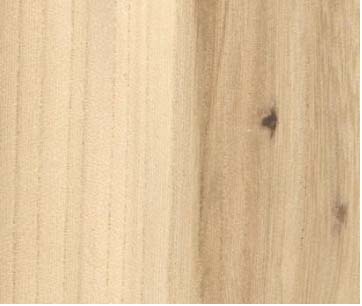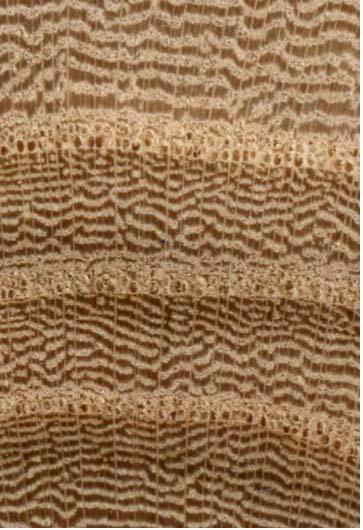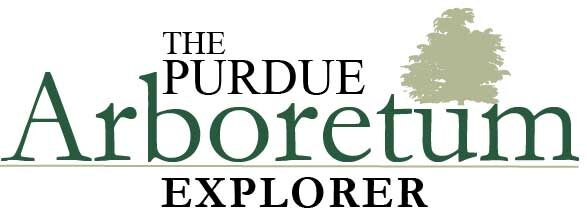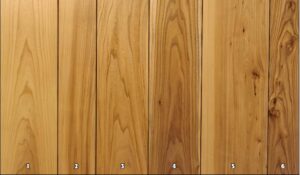Ulmus Americana
Summary
This panel shows several different features of elm. Board 1 is a heavy rock elm; Boards 2, 3, and 5 are American elm. The heartwood in all four boards is a light tan color, and the sapwood is lighter as seen in the first piece. However, American and rock elm stain easily, and the lumber can be discolored by stain. Board 1 (rock elm) and Board 3 (American elm) are high quality examples of this species group. Flat sawn elm such as in these two examples will show a distinctive characteristic “ U” or “ V” shaped ring pattern characteristic of ring porous woods. Also evident in the late wood of Board 3 are irregular jagged lines that appear as feathers. This is a unique characteristic of elms and hackberry. Elms exhibit some of the wildest grain patterns of any hardwood. Board 2 is rift to quarter cut and does not exhibit the wild grain characteristics of the other boards. Board 5 is also American elm and shows small spots probably caused by bird peck and some pin and larger knots. Boards 4 and 6 are red elm. Red elm has a darker red brown color than the other two. Board 4 shows a few small pin knots. Board 6 is from the heart of the tree and shows many small pin knots in the center and along its length. Young stems have numerous small branches growing from the main trunk and cause this characteristic.
History
American elm (Ulmus Americana L.), also called soft elm, grey elm, or white elm, was the most common species that developed into large trees. The species ranges from New Brunswick to central Florida then west to central Texas and north to southeastern Saskatchewan and then back east. The largest American elm at 4½ feet above the ground is about 7.35 feet in diameter. Some trees still persist, but by the end of the 1960s, this species was decimated by the Dutch Elm disease.
Color & Texture

Elm is a ring porous wood like oak and ash. Elm is reported to have a straight or interlocked grain. Interlocked grain results from the longitudinal cells spiraling slightly in one direction, and then after a few years, they spiral in the opposite direction. As a result, the grain is interlocked and the wood is very hard to split, and the lumber tends not to stay flat when drying. The color of elm wood can vary substantially. The sapwood is typically white or grayish white. Young trees of American elm tend to have a wide sapwood and a light brown to grayish heartwood. The sapwood darkens due to staining. Red elm typically has a wide heartwood with a very characteristic red brown color.
Anatomical and Microscopy

Wood Properties
- Workability
- With an interlocked grain, most elm is not considered a very good wood for planing, shaping, and turning.
Because of its higher density, rock elm may tend to work better. - Strength
- At 12 percent moisture content, the average weight of American and red elm is 36 pounds per cubic foot, and rock
elm is considerably heavier at 44 pounds per cubic foot. Elms are intermediate in strength. - Steam Bending
- Elm is rated as one of the better woods for bending.
- Drying
- Elm can be dried using a moderate kiln schedule. Because of the interlocked grain pattern, the wood tends to
warp badly when dried unless properly stacked and heavily weighted to prevent warping. - Shrinkage
- Elm has a moderately high to high shrinkage given its intermediate weight.
- Decay
- The elms have no resistance to decay.
Products
At one time elm was a very important lumber species. It was used for barrel staves and hoops, but it has now been replaced by other materials. It was also used in vehicles and for handle stock. Another application was in children’s wagons and sleds because it would not easily splinter. Other uses include boxes, crates, pallets, agricultural implements, horse stable flooring, furniture, and paneling. Its ability to bend resulted in its use for bent chair parts. Another application that required bending was for the wood trim on old time steamer trunks.

